Caiming Xiong
Salesforce AI Research
Grounded Test-Time Adaptation for LLM Agents
Nov 06, 2025Abstract:Large language model (LLM)-based agents struggle to generalize to novel and complex environments, such as unseen websites or new sets of functions, due to a fundamental mismatch between their pre-training and test-time conditions. This challenge stems from two distinct failure modes: a syntactic misunderstanding of environment-specific components like observation formats, and a semantic misunderstanding of state-transition dynamics, which are only revealed at test time. To address these issues, we propose two distinct and complementary strategies for adapting LLM agents by leveraging environment-specific information available during deployment. First, an online distributional adaptation method parameterizes environmental nuances by learning a lightweight adaptation vector that biases the model's output distribution, enabling rapid alignment with an environment response format. Second, a deployment-time dynamics grounding method employs a persona-driven exploration phase to systematically probe and learn the environment's causal dynamics before task execution, equipping the agent with a nonparametric world model. We evaluate these strategies across diverse agentic benchmarks, including function calling and web navigation. Our empirical results show the effectiveness of both strategies across all benchmarks with minimal computational cost. We find that dynamics grounding is particularly effective in complex environments where unpredictable dynamics pose a major obstacle, demonstrating a robust path toward more generalizable and capable LLM-based agents. For example, on the WebArena multi-site split, this method increases the agent's success rate from 2% to 23%.
Reasoning Curriculum: Bootstrapping Broad LLM Reasoning from Math
Oct 30, 2025Abstract:Reinforcement learning (RL) can elicit strong reasoning in large language models (LLMs), yet most open efforts focus on math and code. We propose Reasoning Curriculum, a simple two-stage curriculum that first elicits reasoning skills in pretraining-aligned domains such as math, then adapts and refines these skills across other domains via joint RL. Stage 1 performs a brief cold start and then math-only RL with verifiable rewards to develop reasoning skills. Stage 2 runs joint RL on mixed-domain data to transfer and consolidate these skills. The curriculum is minimal and backbone-agnostic, requiring no specialized reward models beyond standard verifiability checks. Evaluated on Qwen3-4B and Llama-3.1-8B over a multi-domain suite, reasoning curriculum yields consistent gains. Ablations and a cognitive-skill analysis indicate that both stages are necessary and that math-first elicitation increases cognitive behaviors important for solving complex problems. Reasoning Curriculum provides a compact, easy-to-adopt recipe for general reasoning.
LiveResearchBench: A Live Benchmark for User-Centric Deep Research in the Wild
Oct 16, 2025Abstract:Deep research -- producing comprehensive, citation-grounded reports by searching and synthesizing information from hundreds of live web sources -- marks an important frontier for agentic systems. To rigorously evaluate this ability, four principles are essential: tasks should be (1) user-centric, reflecting realistic information needs, (2) dynamic, requiring up-to-date information beyond parametric knowledge, (3) unambiguous, ensuring consistent interpretation across users, and (4) multi-faceted and search-intensive, requiring search over numerous web sources and in-depth analysis. Existing benchmarks fall short of these principles, often focusing on narrow domains or posing ambiguous questions that hinder fair comparison. Guided by these principles, we introduce LiveResearchBench, a benchmark of 100 expert-curated tasks spanning daily life, enterprise, and academia, each requiring extensive, dynamic, real-time web search and synthesis. Built with over 1,500 hours of human labor, LiveResearchBench provides a rigorous basis for systematic evaluation. To evaluate citation-grounded long-form reports, we introduce DeepEval, a comprehensive suite covering both content- and report-level quality, including coverage, presentation, citation accuracy and association, consistency and depth of analysis. DeepEval integrates four complementary evaluation protocols, each designed to ensure stable assessment and high agreement with human judgments. Using LiveResearchBench and DeepEval, we conduct a comprehensive evaluation of 17 frontier deep research systems, including single-agent web search, single-agent deep research, and multi-agent systems. Our analysis reveals current strengths, recurring failure modes, and key system components needed to advance reliable, insightful deep research.
ToolLibGen: Scalable Automatic Tool Creation and Aggregation for LLM Reasoning
Oct 09, 2025



Abstract:Large Language Models (LLMs) equipped with external tools have demonstrated enhanced performance on complex reasoning tasks. The widespread adoption of this tool-augmented reasoning is hindered by the scarcity of domain-specific tools. For instance, in domains such as physics question answering, suitable and specialized tools are often missing. Recent work has explored automating tool creation by extracting reusable functions from Chain-of-Thought (CoT) reasoning traces; however, these approaches face a critical scalability bottleneck. As the number of generated tools grows, storing them in an unstructured collection leads to significant retrieval challenges, including an expanding search space and ambiguity between function-related tools. To address this, we propose a systematic approach to automatically refactor an unstructured collection of tools into a structured tool library. Our system first generates discrete, task-specific tools and clusters them into semantically coherent topics. Within each cluster, we introduce a multi-agent framework to consolidate scattered functionalities: a code agent refactors code to extract shared logic and creates versatile, aggregated tools, while a reviewing agent ensures that these aggregated tools maintain the complete functional capabilities of the original set. This process transforms numerous question-specific tools into a smaller set of powerful, aggregated tools without loss of functionality. Experimental results demonstrate that our approach significantly improves tool retrieval accuracy and overall reasoning performance across multiple reasoning tasks. Furthermore, our method shows enhanced scalability compared with baselines as the number of question-specific increases.
WALT: Web Agents that Learn Tools
Oct 01, 2025Abstract:Web agents promise to automate complex browser tasks, but current methods remain brittle -- relying on step-by-step UI interactions and heavy LLM reasoning that break under dynamic layouts and long horizons. Humans, by contrast, exploit website-provided functionality through high-level operations like search, filter, and sort. We introduce WALT (Web Agents that Learn Tools), a framework that reverse-engineers latent website functionality into reusable invocable tools. Rather than hypothesizing ad-hoc skills, WALT exposes robust implementations of automations already designed into websites -- spanning discovery (search, filter, sort), communication (post, comment, upvote), and content management (create, edit, delete). Tools abstract away low-level execution: instead of reasoning about how to click and type, agents simply call search(query) or create(listing). This shifts the computational burden from fragile step-by-step reasoning to reliable tool invocation. On VisualWebArena and WebArena, WALT achieves higher success with fewer steps and less LLM-dependent reasoning, establishing a robust and generalizable paradigm for browser automation.
GUI-KV: Efficient GUI Agents via KV Cache with Spatio-Temporal Awareness
Oct 01, 2025Abstract:Graphical user interface (GUI) agents built on vision-language models have emerged as a promising approach to automate human-computer workflows. However, they also face the inefficiency challenge as they process long sequences of high-resolution screenshots and solving long-horizon tasks, making inference slow, costly and memory-bound. While key-value (KV) caching can mitigate this, storing the full cache is prohibitive for image-heavy contexts. Existing cache-compression methods are sub-optimal as they do not account for the spatial and temporal redundancy of GUIs. In this work, we first analyze attention patterns in GUI agent workloads and find that, unlike in natural images, attention sparsity is uniformly high across all transformer layers. This insight motivates a simple uniform budget allocation strategy, which we show empirically outperforms more complex layer-varying schemes. Building on this, we introduce GUI-KV, a plug-and-play KV cache compression method for GUI agents that requires no retraining. GUI-KV combines two novel techniques: (i) spatial saliency guidance, which augments attention scores with the L2 norm of hidden states to better preserve semantically important visual tokens, and (ii) temporal redundancy scoring, which projects previous frames' keys onto the current frame's key subspace to preferentially prune redundant history. Across standard GUI agent benchmarks and models, GUI-KV outperforms competitive KV compression baselines, closely matching full-cache accuracy at modest budgets. Notably, in a 5-screenshot setting on the AgentNetBench benchmark, GUI-KV reduces decoding FLOPs by 38.9% while increasing step accuracy by 4.1% over the full-cache baseline. These results demonstrate that exploiting GUI-specific redundancies enables efficient and reliable agent performance.
SCUBA: Salesforce Computer Use Benchmark
Sep 30, 2025Abstract:We introduce SCUBA, a benchmark designed to evaluate computer-use agents on customer relationship management (CRM) workflows within the Salesforce platform. SCUBA contains 300 task instances derived from real user interviews, spanning three primary personas, platform administrators, sales representatives, and service agents. The tasks test a range of enterprise-critical abilities, including Enterprise Software UI navigation, data manipulation, workflow automation, information retrieval, and troubleshooting. To ensure realism, SCUBA operates in Salesforce sandbox environments with support for parallel execution and fine-grained evaluation metrics to capture milestone progress. We benchmark a diverse set of agents under both zero-shot and demonstration-augmented settings. We observed huge performance gaps in different agent design paradigms and gaps between the open-source model and the closed-source model. In the zero-shot setting, open-source model powered computer-use agents that have strong performance on related benchmarks like OSWorld only have less than 5\% success rate on SCUBA, while methods built on closed-source models can still have up to 39% task success rate. In the demonstration-augmented settings, task success rates can be improved to 50\% while simultaneously reducing time and costs by 13% and 16%, respectively. These findings highlight both the challenges of enterprise tasks automation and the promise of agentic solutions. By offering a realistic benchmark with interpretable evaluation, SCUBA aims to accelerate progress in building reliable computer-use agents for complex business software ecosystems.
LoCoBench: A Benchmark for Long-Context Large Language Models in Complex Software Engineering
Sep 11, 2025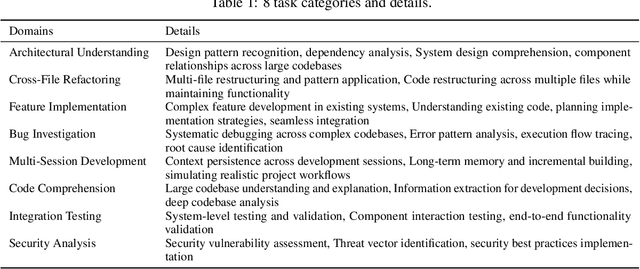
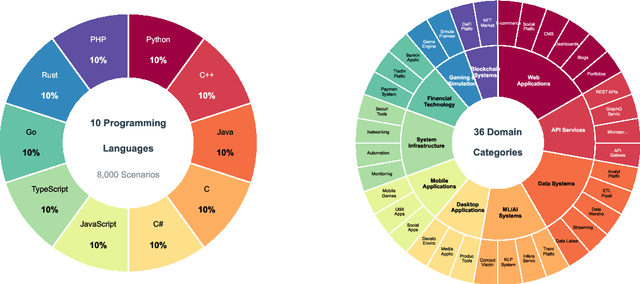
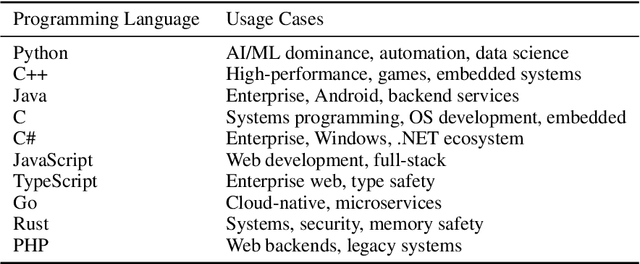

Abstract:The emergence of long-context language models with context windows extending to millions of tokens has created new opportunities for sophisticated code understanding and software development evaluation. We propose LoCoBench, a comprehensive benchmark specifically designed to evaluate long-context LLMs in realistic, complex software development scenarios. Unlike existing code evaluation benchmarks that focus on single-function completion or short-context tasks, LoCoBench addresses the critical evaluation gap for long-context capabilities that require understanding entire codebases, reasoning across multiple files, and maintaining architectural consistency across large-scale software systems. Our benchmark provides 8,000 evaluation scenarios systematically generated across 10 programming languages, with context lengths spanning 10K to 1M tokens, a 100x variation that enables precise assessment of long-context performance degradation in realistic software development settings. LoCoBench introduces 8 task categories that capture essential long-context capabilities: architectural understanding, cross-file refactoring, multi-session development, bug investigation, feature implementation, code comprehension, integration testing, and security analysis. Through a 5-phase pipeline, we create diverse, high-quality scenarios that challenge LLMs to reason about complex codebases at unprecedented scale. We introduce a comprehensive evaluation framework with 17 metrics across 4 dimensions, including 8 new evaluation metrics, combined in a LoCoBench Score (LCBS). Our evaluation of state-of-the-art long-context models reveals substantial performance gaps, demonstrating that long-context understanding in complex software development represents a significant unsolved challenge that demands more attention. LoCoBench is released at: https://github.com/SalesforceAIResearch/LoCoBench.
Strefer: Empowering Video LLMs with Space-Time Referring and Reasoning via Synthetic Instruction Data
Sep 03, 2025
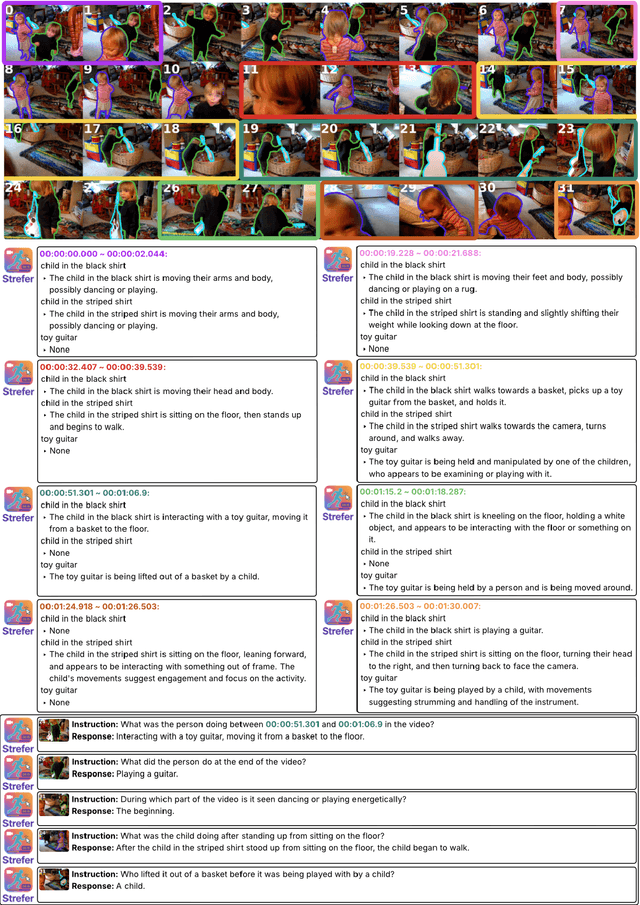

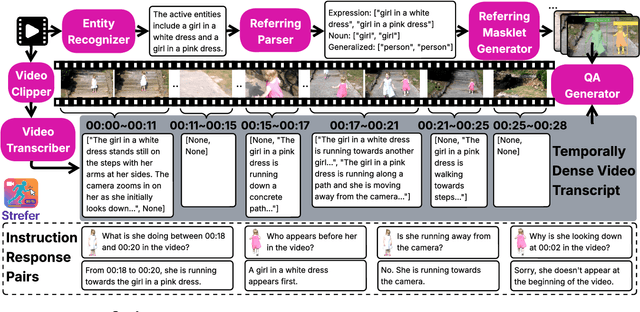
Abstract:Next-generation AI companions must go beyond general video understanding to resolve spatial and temporal references in dynamic, real-world environments. Existing Video Large Language Models (Video LLMs), while capable of coarse-level comprehension, struggle with fine-grained, spatiotemporal reasoning, especially when user queries rely on time-based event references for temporal anchoring, or gestural cues for spatial anchoring to clarify object references and positions. To bridge this critical gap, we introduce Strefer, a synthetic instruction data generation framework designed to equip Video LLMs with spatiotemporal referring and reasoning capabilities. Strefer produces diverse instruction-tuning data using a data engine that pseudo-annotates temporally dense, fine-grained video metadata, capturing rich spatial and temporal information in a structured manner, including subjects, objects, their locations as masklets, and their action descriptions and timelines. Our approach enhances the ability of Video LLMs to interpret spatial and temporal references, fostering more versatile, space-time-aware reasoning essential for real-world AI companions. Without using proprietary models, costly human annotation, or the need to annotate large volumes of new videos, experimental evaluations show that models trained with data produced by Strefer outperform baselines on tasks requiring spatial and temporal disambiguation. Additionally, these models exhibit enhanced space-time-aware reasoning, establishing a new foundation for perceptually grounded, instruction-tuned Video LLMs.
MCP-Universe: Benchmarking Large Language Models with Real-World Model Context Protocol Servers
Aug 20, 2025Abstract:The Model Context Protocol has emerged as a transformative standard for connecting large language models to external data sources and tools, rapidly gaining adoption across major AI providers and development platforms. However, existing benchmarks are overly simplistic and fail to capture real application challenges such as long-horizon reasoning and large, unfamiliar tool spaces. To address this critical gap, we introduce MCP-Universe, the first comprehensive benchmark specifically designed to evaluate LLMs in realistic and hard tasks through interaction with real-world MCP servers. Our benchmark encompasses 6 core domains spanning 11 different MCP servers: Location Navigation, Repository Management, Financial Analysis, 3D Design, Browser Automation, and Web Searching. To ensure rigorous evaluation, we implement execution-based evaluators, including format evaluators for agent format compliance, static evaluators for time-invariant content matching, and dynamic evaluators that automatically retrieve real-time ground truth for temporally sensitive tasks. Through extensive evaluation of leading LLMs, we find that even SOTA models such as GPT-5 (43.72%), Grok-4 (33.33%) and Claude-4.0-Sonnet (29.44%) exhibit significant performance limitations. In addition, our benchmark poses a significant long-context challenge for LLM agents, as the number of input tokens increases rapidly with the number of interaction steps. Moreover, it introduces an unknown-tools challenge, as LLM agents often lack familiarity with the precise usage of the MCP servers. Notably, enterprise-level agents like Cursor cannot achieve better performance than standard ReAct frameworks. Beyond evaluation, we open-source our extensible evaluation framework with UI support, enabling researchers and practitioners to seamlessly integrate new agents and MCP servers while fostering innovation in the rapidly evolving MCP ecosystem.
 Add to Chrome
Add to Chrome Add to Firefox
Add to Firefox Add to Edge
Add to Edge